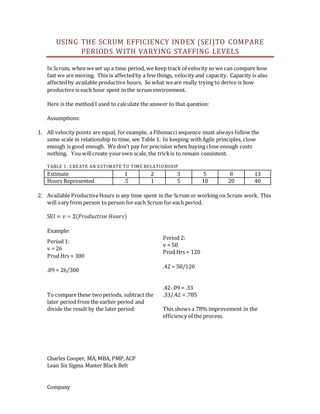
Scrum Efficiency Index
- 1. Company USING THE SCRUM EFFICIENCY INDEX (SEI)TO COMPARE PERIODS WITH VARYING STAFFING LEVELS In Scrum, when weset up a time period, we keep track of velocity so we can compare how fast we are moving. This is affectedby a few things, velocity and capacity. Capacity is also affectedby available productive hours. So what weare really trying to derive is how productive is each hour spent in the scrum environment. Here is the method I used to calculate the answer to that question: Assumptions: 1. All velocity points are equal, forexample, a Fibonaccisequence must always follow the same scale in relationship to time, see Table 1. In keeping withAgile principles, close enough is good enough. We don’t pay for precision when buying close enough costs nothing. You willcreate yourown scale, the trickis to remain consistent. TABLE 1: CREATE AN ESTIMATE TO TIME RELATIONSHIP Estimate 1 2 3 5 8 13 Hours Represented .5 1 5 10 20 40 2. Available ProductiveHours is any time spent in the Scrum or working on Scrum work. This will vary from person to person for each Scrum for each period. SEI = 𝑣 ÷ Σ(𝑃𝑟𝑜𝑑𝑢𝑐𝑡𝑖𝑣𝑒 𝐻𝑜𝑢𝑟𝑠) Example: Period 1: v = 26 Prod Hrs = 300 .09 = 26/300 Period 2: v = 50 Prod Hrs = 120 .42 = 50/120 To compare these twoperiods, subtract the later period from the earlier period and divide the result by the later period: .42-.09 = .33 .33/.42 = .785 This shows a 78% improvement in the efficiency of the process. Charles Cooper, MA, MBA, PMP,ACP Lean Six Sigma Master Black Belt